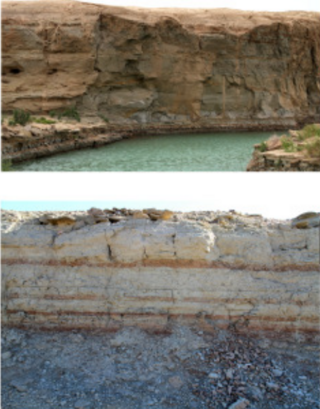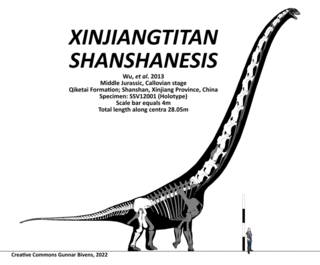
Mamenchisaurus is a genus of sauropod dinosaur known for their remarkably long necks which made up nearly half the total body length. Numerous species have been assigned to the genus; however, the validity of these assignments has been questioned. Fossils have been found in the Sichuan Basin and Yunnan Province in China. Several species from the Upper Shaximiao Formation, whose geologic age is uncertain, have been described. However, evidence suggests this formation to be no earlier than the Oxfordian stage of the Late Jurassic. M. sinocanadorum dates to the Oxfordian stage, and M. anyuensis to the Aptian stage of the Early Cretaceous. Most species were medium-large to large sauropods, measuring roughly 15 to 26 meters in length—possibly up to 35 meters (115 ft), based on two undescribed vertebrae.

Bellusaurus was a small short-necked sauropod dinosaur from the Late Jurassic (Oxfordian) which measured about 4.8 metres (16 ft) long. Its fossils were found in Shishugou Formation rocks in the northeastern Junggar Basin in China.
Chiayusaurus is a genus of sauropod dinosaur known from teeth found in China and possibly also South Korea. Two species have been named for this obscure genus, though only the type, C. lacustris, is still seen as valid. It was originally named as Chiayüsaurus, but the ICZN does not permit special characters, so the name was corrected to Chiayusaurus. The obsolete name can still be seen in older sources, though. As a sauropod, Chiayusaurus would have been a large, quadrupedal herbivore.

Hudiesaurus is a herbivorous sauropod genus of dinosaur from China. Its fossil remains were found in 1993 by a Chinese-Japanese expedition near Qiketai in Shanshan, Xinjiang province. The genus contains a single species, Hudiesaurus sinojapanorum, was named and described by Dong Zhiming in 1997. The generic name is derived from Mandarin hudie, meaning "butterfly," and refers to a flat butterfly-shaped process on the front base of the vertebral spine. The specific name refers to the members of the Sino-Japan Silk Road Dinosaur Expedition but can also be read as "central part" in Chinese, a pun on the Japanese Chunichi Shimbun press group, which financed the research.

Klamelisaurus is a genus of herbivorous sauropod dinosaur from the Middle Jurassic Shishugou Formation of China. The type species is Klamelisaurus gobiensis, which was named by Zhao Xijin in 1993, based on a partial skeleton discovered in 1982 near the abandoned town of Jiangjunmiao. Zhao described Klamelisaurus as the only member of a new subfamily, Klamelisaurinae, among the now-defunct primitive sauropod order Bothrosauropodoidea. Since Zhao's description, Klamelisaurus received limited attention from researchers until Andrew Moore and colleagues redescribed it in 2020.

Camarasauridae is a family of sauropod dinosaurs. Among sauropods, camarasaurids are small to medium-sized, with relatively short necks. They are visually identifiable by a short skull with large nares, and broad, spatulate teeth filling a thick jaw. Based on cervical vertebrae and cervical rib biomechanics, camarasaurids most likely moved their necks in a vertical, rather than horizontal, sweeping motion, in contrast to most diplodocids.
The Shishugou Formation is a geological formation in Xinjiang, China.

The Tugulu Group is a geological Group in Xinjiang, China whose strata date back to the Early Cretaceous. Dinosaur skeletal remains and footprints are among the fossils that have been recovered from the formation.

Eusauropoda is a derived clade of sauropod dinosaurs. Eusauropods represent the node-based group that includes all descendant sauropods starting with the basal eusauropods of Shunosaurus, and possibly Barapasaurus, and Amygdalodon, but excluding Vulcanodon and Rhoetosaurus. The Eusauropoda was coined in 1995 by Paul Upchurch to create a monophyletic new taxonomic group that would include all sauropods, except for the vulcanodontids.
The Qigu Formation is a Late Jurassic (Oxfordian) geologic formation in the Southern Junggar Basin in China. Indeterminate Dinosaur remains are among the fossils that have been recovered from the formation, including theropod teeth and a fibula. a stegosaur dorsal vertebra and a Eusauropod tooth. Xinjiangtitan was erroneously thought to be from this formation, but it is actually from the older Qiketai Formation, which is in a different basin. The term "Qigu Formation" is also used to sediments of equivalent age in the Turpan Basin, but this might better be treated as a separate formation. It is laterally equivalent to the Shishugou Formation.
The Lianmuqin Formation, also transcribed as Lianmugin Formation, and Lianmuxin Formation, is an Early Cretaceous geologic formation composed of "interbedded red green and yellow variegated mudstones and siltstones". Dinosaur remains have been recovered from it.
The Toutunhe Formation is a Late Jurassic geological formation in China, specifically dating to the Oxfordian and Kimmeridgian stages. Dinosaur remains diagnostic to the genus level are among the fossils that have been recovered from the formation. The lower portion of the formation consists of grey to reddish mudstone with medium to coarse grained cross bedded sandstone, while the upper portion consists primarily of brown-red-purple mudstone, interbedded with fine to medium grained laminated sandstone.
The Kurek Formation is a late Oxfordian geologic formation of the Kugitang Svita in Turkmenistan and Uzbekistan. Fossil sauropod tracks have been reported from the formation.
The Zhenzhuchong Formation is an Early Jurassic geologic formation in China. Plesiosaur remains are among the fossils that have been recovered from its strata. Remains of the prosauropod Lufengosaurus huenei have been recovered from this formation As well as dinosaur footprints.

Xinjiangtitan is an extinct genus of mamenchisaurid sauropod that lived during the Middle Jurassic of what is now Xinjiang, northwestern China. Its type and only species is Xinjiangtitan shanshanesis, known from a single incomplete skeleton recovered from the Qiketai Formation. The holotype preserves one of the most complete vertebral columns of any sauropod found in Asia, and has the longest complete neck known for any animal.
The Qiketai Formation is a geological formation in Xinjiang, China. It is found within the Turpan-Hami Basin. It is roughly equivalent in age to the nearby Toutunhe Formation and Wucaiwan Formation of the Southern and Northern Junggar Basin, respectively. Tuffites within the unit have been dated to the Callovian stage of the Jurassic approximately 164.6 ± 1.4 ma. The dinosaur Xinjiangtitan is known from the formation.
Fushanosaurus is a genus of sauropod dinosaur from the Shishugou Formation from Xinjiang Province in China. The type and only species is Fushanosaurus qitaiensis. It is solely known from the holotype specimen FH000101, a complete right femur.

The Shengjinkou Formation is an Early Cretaceous (Aptian)-aged Konservat-Lagerstätte composed of "interbedded red green and yellow variegated mudstones and siltstones" that is part of the larger Tugulu Group of China. Dinosaur and pterosaur remains have been recovered from the formation.
Rhomaleopakhus is a genus of mamenchisaurid sauropod, dinosaur from the Late Jurassic Kalaza Formation of China. The type and only species is Rhomaleopakhus turpanensis.







